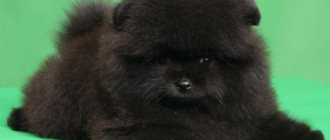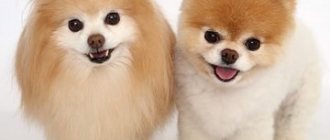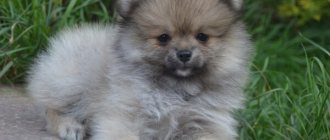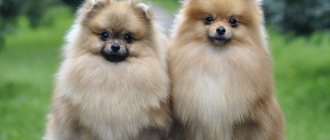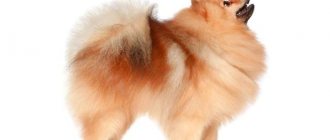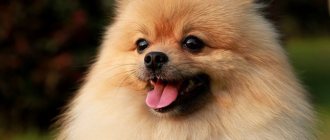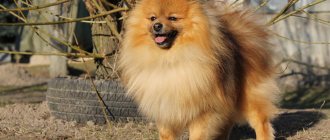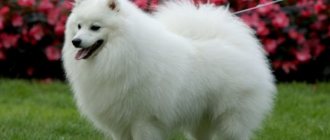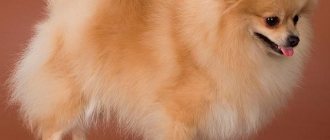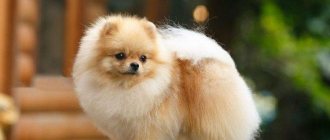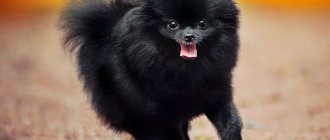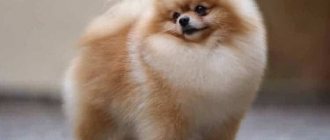Appearance
The fact is that the bear type is not a separate species from the Pomeranian. In essence, there is no difference between them. Subspecies appeared as a result of a long period of breeding: fox, bear and baby buck. The fox-faced Pomeranian is considered standard. The name “bear type” is associated with the characteristics of the individuals’ heads.
— Advertising —
The Bear Spitz has a round head, the muzzle is slightly flattened and shortened. The eyes are round, close together, and the tip of the nose is slightly raised.
These are tiny dogs. As a rule, they weigh from 2 to 3 kg, and the height at the withers ranges from 12 to 28 cm.
The rest of the body looks the same for all types.
— Advertising —
Animals have a strong constitution. The dog has a short and straight back. The tail is bushy, set high, and lies flat and straight on the back.
The chest is wide and well developed.
The forelimbs are straight, the shoulder blades are long. The paws are rounded, with black soft pads. The hind limbs are muscular and run parallel to each other.
The pet's coat is usually thick and has a double layer. It is known that the top layer is rough, and the inner layer is smooth and delicate.
The dog comes in different colors. These include: white, cream, brown, black, sable, orange, tan, chocolate, gray and so on.
Not many people know that the animals are miniature versions of the large sled dogs of the Arctic.
Description and standard
Bear-type Pomeranians are born in the same litter with puppies that have an elongated muzzle. It is almost impossible to predict or plan their appearance, since mating, especially by amateurs, of two individuals of this type can lead to the birth of weak or sick puppies.
Pomeranian standard
:
- square body;
- the back is straight, short;
- The chest is wide, the croup is straight;
- medium length tail;
- paws straight, spaced wide apart, pads small, collected;
- straight or scissor bite, absence of premolars is acceptable;
- the eyes are small, almond-shaped, dark brown;
- The ears are triangular in shape and pointed.
The “cubs” have a rounded head, a flattened muzzle, and a nose with a black lobe located slightly higher than that of other Pomeranians. The main difference between bear-type Spitz and other miniature dogs is the presence of plump cheeks, which are formed by thick hair on the cheekbones.
Pros and cons of a dog
Pros of the type:
- The Pomeranian bear cub has an optimistic character.
- They are ideal companion dogs that require a lot of attention from their owners. In return, the Pomeranian gives love and affection to its family.
- Pets love to participate in everything that happens around them.
- Despite their small size, Pomeranians are active and prefer long walks.
- Spitz are very vigilant and have a highly developed protective instinct. They make good watchdogs that will always warn their owners with loud barks.
- Animals are suitable for families with adult children and elderly people.
- Pets are smart and learn quickly. The only difficulty may be the species' addiction to dominance, but this can be easily avoided with proper upbringing from early childhood.
- Dogs get along well with other pets.
Disadvantages of the type:
- Potential owners must be prepared and patient during Pomeranian obedience training.
- The breed should not be owned by families with small children. Kids may miscalculate their strength and choke their pets.
- Pomeranians love to bark. This can be a problem for owners who live in an apartment.
- Animal fur requires daily care.
- They shed a lot.
- Birds such as eagles, hawks and owls will happily fly away with a Pomeranian in their talons. You will need to constantly supervise your little Pomeranian while he is playing outside.
- The dog cannot stand loneliness. Therefore, if all family members leave home for more than seven to eight hours, then this dog is not for you.
Advantages and disadvantages
The main advantages are considered to be the large supply of energy and cheerfulness of this dog. Spitz dogs are easy to train and achieve great success in this, mastering circus and acrobatic tricks and coming into contact with people. They love children very much and do not hurt them. In terms of cleanliness they are comparable to cats. By dog standards they are long-lived.
Among the obvious disadvantages, one can note the animal’s slight excitability, accompanied by a loud, high-pitched bark, which can last for quite a long time. Also, the fearless nature of the Spitz clearly does not correspond to its size , so the owners will have to be careful with it on the street and when in contact with other dogs.
This is the breed, these black Pomeranian Spitz. In return for your care, the little dog will give you his love and affection and become your family’s best friend. What do you think about the methods of raising Spitz dogs and teaching them various tricks? What nicknames would suit a black Spitz best? Write your options in the comments. Love your four-legged friends!
History of the origin of the breed
The breed was developed in Pomerania, Germany. The Pomeranian Spitz has served man with devotion for more than four hundred years. Initially, this animal was used as a watchman and shepherd. Then the dog weighed on average 13-14 kg.
At the end of the 19th century, a miniature version of the breed gained popularity. Her weight was about 4-5 kg. This reduction in body weight is associated with the British Queen Victoria, who was a fan of the species. But the dogs she kept were many times smaller than the then common size.
Over time, these kids became real friends and companions of people. There are many great names associated with this breed. For example, Mozart. The great composer dedicated one of his works to his favorite. Frederic Chopin wrote "Waltz of the Dog" while his little friend was chasing his own tail.
In England, the breed standard was written at the end of the 19th century. Later, the species was recognized by the American Kennel Club. This happened in 1900.
Nowadays, this breed is used to treat stress and depression in people in Europe. The owner can take the pet with him always and everywhere due to its light weight.
Kinds
Mini or dwarf
Miniature or dwarf Pomeranians are charming creatures that thrive in apartments. The individual has a standard appearance and a very compact body. The pet has fur that is fluffy and dense to the touch, and comes in many different colors. The dog's head is small, round in shape, expressive eyes, small ears.
Many people are interested in how much does a dwarf Spitz cost? The price of a puppy from a good professional nursery varies from $500 to $1000.
Classic animals of standard or mini sizes are the best choice for home keeping. Such dogs are not too whimsical and do not require such careful care as, for example, the bear type.
Maintenance and care
Many people are interested in how to properly care for a bear-type Pomeranian? Caring for the breed is not difficult, but it has some peculiarities.
- The main pride of these animals is their luxurious wool. Brush them twice a week. A more frequent procedure may leave your pet without undercoat.
- An adult bear-type Pomeranian does not need frequent bathing. Wash it before exhibitions, in cases where it gets wet during a walk and during heavy shedding. Brush your pet thoroughly before bathing.
- The weak point of dwarf breeds is often their teeth. Clean them with specially designed brushes. This is necessary to prevent periodontitis.
- Periodically wipe your eyes with damp swabs, which can be moistened with plain boiled water.
- Visit your groomer periodically. However, in summer you should not cut the dog completely, as the coat helps the dog protect its skin from the scorching sun. You can ask a specialist to give your Pomeranian a bear haircut. Then he will look even cuter.
- Go to the vet every six months. He will create a vaccination schedule and also examine your pet for diseases. Periodically carry out deworming and flea prevention. Check your pet daily for ticks.
Caring for a light coat
White color is beautiful and aesthetically pleasing, but caring for light coat is expensive. The axial hair in the coat can be white, and the undercoat of a Spitz is gray. The type of dog with these matches can wear ten different shades.
Grooming216 requires a lot of money
Problems owners face:
- Light gray, like a dusty shade of wool. In most cases, the dog is actually covered in dust. Walking the city streets, exploring the backyard, or chasing someone's cat turns a snow-white cloud into a gray and unremarkable one. Fortunately, this problem is very easy to fix. It is enough to bathe with a special shampoo for white coat Iv San Bernard Black&White. Cost per bottle is 380 rubles. It is better not to experiment with the choice of shampoo, especially before an upcoming exhibition - this can lead to dulling of the coat and the appearance of dandruff.
- Brown fur on your dog's face, paws and around the eyes can be eliminated with hydrogen peroxide. Rub the brown fur with a disc soaked in peroxide. After one procedure, the muzzle will become noticeably lighter.
- There is another way to lighten problem areas. Talc, potato starch and boric acid are added to boiled water, stirred until mushy and applied to brown spots. After drying, this mask is combed out. After three procedures, the coat becomes snow-white again.
Spitz dogs need to be taken to a groomer - he will be able to give the dog’s coat a well-groomed appearance. There are many funny hairstyles. And dyeing light fur will allow the dog groomer's imagination to run wild. He can turn a Spitz into a tiger or a panda bear.
Panda color
Nutrition
There is one important thing you should remember throughout your dog's life - he needs a balanced diet. You should carefully read the label before purchasing food. The veterinary manual prescribes that the dog’s diet should provide a minimum protein content, namely 18% per day. Also a minimum fat content, namely 5% per day. It is important to find a food that contains omega fatty acids, vitamins and minerals. Avoid foods that contain a lot of chemical ingredients and dyes.
What kind of human food can you give to your pet?
You can also give Pomeranians human food. These include:
- Sources of protein. Chicken, turkey, lamb, fish, beef liver, chicken liver, pork, venison, shrimp, crawfish.
- Vegetables. Asparagus, beets, bell peppers, broccoli, cauliflower, carrots, cucumber, green beans, cabbage, spinach, lettuce, peas, potatoes, zucchini.
- Carbohydrates. Porridge, pasta.
- Natural fats. Sunflower seeds, peanut butter, peanuts, flaxseeds, cashews.
- Other products. eggs, cottage cheese, cheese, honey, apples, banana, blueberries, melon, kiwi, oranges, nectarines, peaches, pear, pineapple, plums, pumpkin, mango, raspberries, strawberries.
Avoid giving your Pomeranian the following foods frequently: bread, crackers, coconut, popcorn, potato chips, marshmallows, bacon, pancakes, waffles. They may upset your friend's digestion.
Never feed Pomeranians the following foods: onions, garlic, chocolate, grapes (including juices, jams and jellies), raisins, currants, cinnamon, mushrooms, pecans, walnuts, macadamia nuts, cherries (and other small-seeded fruits) or seeds), yeast dough.
An adult Spitz should consume the following amounts of food per day, depending on weight and activity:
- 1 kg – from 24 to 31 g.
- 1.5 kg – from 32 to 42 g.
- 2 kg – from 40 to 53 g.
- 2.5 kg – from 47 to 62 g.
Pomeranians burn calories much faster than some other breeds. This is due to their small size and high activity level. Divide your pet's food into three or four meals per day. This will help the animals continuously produce the required level of energy.
How to feed?
You can feed Spitz cubs with both natural products and industrial feed.
The main thing is to keep your diet balanced and not mix both types of nutrition. The number of daily feedings depends on the age of the dog:
- up to 2 months – 5 times;
- 3-5 months – 4 times;
- 6-9 months – 3 times;
- 10 months and older – 2 times.
Natural feeding allows the owner to independently choose products and control their quality, but preparing food for a pet takes quite a lot of time and effort. In addition, it is impossible to create a balanced, nutritious diet without having certain knowledge in the field of veterinary nutrition.
When eating natural foods, your diet should include:
- boiled lean meat;
- offal;
- rice, buckwheat and oatmeal;
- sea fish;
- eggs (maximum 2 pieces per week);
- low-fat fermented milk products;
- vegetables, fruits and herbs.
It is forbidden to feed your pet:
- sweets, pickles, marinades;
- pasta and bakery products;
- spicy, smoked, fried foods;
- legumes;
- semolina, pearl barley and millet porridge;
- fatty meat;
- river fish;
- potatoes, onions, cabbage;
- tubular bones.
As a treat, you can give your orange a piece of cheese, fruit, or vegetable. It is also necessary to include a vitamin-mineral complex in the diet.
The main advantage of industrial feeds is that they have a balanced composition enriched with vitamins and minerals. Plus, they are easy to use and store and require no cooking. But you need to choose them very carefully, because if an allergy occurs to one of the components of the food, you will have to change your pet’s entire diet.
IMPORTANT!
The composition should not contain dyes, flavors, flavor enhancers and other chemicals.
For bear-type Pomeranians, food of at least premium class is suitable, ideally super-premium or holistic. Popular foods are Hills, Natural Holistic, Purina Pro Plan, GO!, Almo Nature Holistic, NOW, Origen, Acana, Barking Heads.
Girl
Many people have the preconceived idea that a female Pomeranian is superior to a male. However, it is not.
They are difficult to distinguish by appearance. The most obvious sign is the genitals of individuals. Some breeders try to find out the sex of the newborn right away. However, even experienced specialists sometimes confuse the umbilical cord with the male genital organs. Therefore, it is possible to determine the gender correctly only after babies reach 3-4 weeks.
An adult girl is usually a little larger than a boy, but this is all individual.
The main thing to remember is that character and temperament depend solely on the individual. In general, girls are playful, funny, and loyal.
One of the inconvenient moments when keeping females is estrus, which occurs several times a year. At this time, the bitch will attract all the males in the area, which can make walking difficult. The female's first estrus occurs when she reaches the age of 6 to 10 months. You can sterilize her, as unsterilized girls are more bossy and capricious.
How to choose your future pet?
It is better to purchase a dog from a specialized nursery. It is necessary to inspect the living conditions of the dogs, meet the parents of the future pet, find out about their health, and ask the breeder for a veterinary passport with notes on vaccinations and deworming.
Watch the puppy. A healthy baby should be active, cheerful, and inquisitive. He should have a shiny coat without dandruff or bald patches, clean skin without rashes or irritations. The baby should not have any discharge from the eyes or ears.
You should buy a dog only after it is 4-5 months old - only at this age can you determine its color and whether it belongs to a certain type.
Boy
Male dogs are more independent than females. Therefore, it is very important to start obedience training from a very young age.
They tend to be less capricious and usually more affectionate than females.
One common complaint about male dogs that you hear most often is that dogs like to “mark” their territory and are difficult to toilet train. You should be tolerant and consistent in training your animal.
It is noteworthy that young puppies urinate the same way, regardless of gender. However, after 6 months, most male dogs will raise their leg while urinating, while female dogs will continue to squat.
Nicknames
For boy
Popular nicknames for boys:
- Prince.
- Lucky.
- Winston.
- Bentley.
- Luther.
- Little bear.
- Chester.
- Edmund.
- Sid.
- Teri.
- Albert.
- Monty.
- Maximilian.
- Mozart.
- Othello.
- Jupiter.
- Phoenix.
- Bean.
- Toby.
- Bertie.
- Callie.
For girl
Popular nicknames for girls:
- Izzy.
- Princess.
- Lei.
- Bella.
- Roxy.
- Esther.
- Athena.
- Foxy.
- Jessica.
- Janie.
- Gina.
- Massey.
- Mini.
- Marilyn.
- Molly.
- Stella.
- Button.
- Lily.
- Moon.
Breeding
A litter usually produces several puppies - from one to three. Breeders try to find parents by weight. It is necessary that the female weighs about 2.5 kg, and the male – 2-2.2 kg.
If the “lady” behaves aggressively towards the “knight”, then she is not yet ready for mating.
The fertilization period is individual for each animal, but usually the optimal moment occurs on days 11-13 of estrus. If everything went well, then on the 58-63rd day the babies are born.
The puppy weighs 55-125 grams at birth. Children are not removed from their nursing mother until they are two months old. They gain up to 10 grams of weight per day if well cared for.
Dog character
The dog is known to be friendly with everyone, and his training will be fun and easy thanks to his bright personality. The bear gets along well with children and other pets.
It should be noted that this breed can be a little aggressive towards other dogs if they feel competition.
Bear Pomeranians make excellent watchdogs as they are very vigilant. They also have the ability to sense danger or changes in the environment. Pets like to bark if they hear suspicious sounds. But barking can be controlled with proper training.
The puppy is very playful. So get him toys that will keep him occupied.
Another feature of the animal is that it likes to be the center of attention. Be sure to surround him with love, which the dog really needs.
Pomeranians are intelligent and eager to learn. Due to their active nature, they perform well as circus dogs. Pets also successfully act in films. However, consistent training is required to get the best out of them.
Education and training
If you want your Pomeranian to be a wonderful companion, he must learn good manners from an early age. Let's consider the main points of education that are recommended for your little friend:
- Homeschooling.
- Obedience training.
- Workout.
As soon as you bring your puppy home, begin training and training for maximum benefit.
The pet is easy to train. It is enough to give a clear command or confidently prohibit an action. However, it should be remembered that the animal will often strive to dominate.
Spitz will happily follow commands that contain elements of dance or play. They will be less able to follow commands such as “sit.” Most likely, this is due to the dog’s increased activity. The animal's favorite command is “fetch.” This word comes from the French "apporter", which means to bring. The Spitz will happily run after an abandoned toy or bring the right thing. Also teach your baby other commands:
- "To me". You should not approach the animal when teaching it this command. Wait, it will understand and come to you on its own.
- "Near". Patience is required for effective absorption.
- "Ugh". When training a team, it is necessary to observe some nuances. For example, don't pull on the leash, yell, or use force.
- "Give". This command is easy to teach when using a ball.
The skills of going to the toilet need to be instilled from the first days. As you watch your puppy, you may notice some warning signs of the urge to relieve yourself. For example, before defecating, the pet will spin around and sniff everything in search of the right place. At this point, it is necessary to transfer it to the tray selected for defecation. Also put your puppy in it after sleep and after eating. Be sure to praise the animal when it performs the action independently and in the right place. Puppies usually quickly get used to eliminating in the litter box. The main rule for you is to be patient and calm.
Pomeranian Spitz Health and Diseases
The Pomeranian's northern origin has given it good health compared to other dwarf breeds. Even in old age, these lively cubs feel great.
Pomeranian Spitz on a walk
The thick coat explains the oranges' predisposition to matting. Some dogs suffer from alopecia - baldness of certain areas of the body. The so-called black skin disease, which is fraught with complete hair loss and pigmentation of the skin, looks especially frightening. However, the disease itself does not harm the health of the Spitz, limiting itself only to the unattractive appearance of the animal.
Merle-colored Pomeranians are most susceptible to disease. They are born deaf, with increased intraocular pressure and coloboma - a defect in the lining of the eyes. There are disturbances in the functioning of the cardiovascular, musculoskeletal and nervous systems.
Typical diseases of Pomeranians include:
- ligament weakness;
- subluxation of the knee joint;
- dysbiosis of the gastrointestinal tract;
- colitis and gastritis;
- cough caused by spasm of the larynx;
- tearfulness;
- atrophy of the retina and tear duct;
- hypoglycemia;
- hydrocephalus.
Rare diseases include tumors and undescended testicles in male dogs.
Diseases
Here are some health problems that are common in Pomeranians:
- Injuries. One of the main causes of death of all individuals. Injuries may include: an accidental fall, being hit by a car or in an accident, trachea being crushed by a leash, and so on.
- Gastrointestinal problems. These include: constipation, inflammatory bowel disease (enterocolitis), pancreatitis, lymphangiectasia (dilation of the lymphatic vessels that are located in the submucosal and mucous layers of the wall of the small intestine), exocrine pancreatic insufficiency, and so on.
- Infections. Problems of this type include: fungal infections, viral diseases (distemper and parvovirus), bacterial infections (such as leptospirosis) and protozoal diseases (such as leishmaniasis and babesiosis).
- Allergy. It can appear under the influence of various factors: food, environment, medications, insects, and so on. If your pet develops symptoms such as sneezing, watery nose, red skin, and itching, contact your veterinarian.
- Separately, it is necessary to highlight the collapse of the trachea. The trachea, or breathing tube, is made up of rings of cartilage that make it look like the ribbed hose of a vacuum cleaner. This structure ensures its flexibility and strength. The cartilaginous rings of the breed are weak. The trachea can collapse and become too narrow due to external factors. This leads to coughing and difficulty breathing. Most cases of collapse are mild. They are treated with medications. When symptoms are severe, surgery is performed.
In any case, if you notice any changes in your dog's behavior or appearance, take him to the vet. Timely help will help cure and sometimes save your pet’s life.
Genetics
Spitz coat color has different types of origin and genetic characteristics:
- Albino. This type of color has a main feature: albinos are often deaf from birth. The paired gene in an albino is deafness. The nose and skin of this type of dog will be pink. Eyes - sky blue. The paw pads and mouth will be light. The claws are transparent.
- White color. Dogs of this color carry a gene that prevents the hair from coloring. The nose and mucous membranes of this type may be brown or black. The claws and skin will also be dark. The gene in such individuals is recessive (easily suppressed), which means that in the next generations puppies with all colors can be born. Babies can be born fawn, and after molting they can turn white.
- Lightened colors. Red, chocolate, saddleback, and spotted Spitz dogs may appear white. Lightening of colors occurs under the influence of many genes. In this case, the nose and claws will also be light in color. Most white Spitz dogs are of this type. The owner may be surprised after molting if a snow-white puppy suddenly turns cream or gray by six months.
Snow white fur
An excellent breed for an apartment. This is not a cat that is “on its own.” Spitz is a friend, looking at whom you always want to smile. Very smart, friendly, with a lot of positivity. A whole sea of kindness. Beady eyes, a button nose, a soft, pleasant fluffy coat. In general, I have only positive emotions.
Oksana 03/14/2018
Snow-white color in the breed standard
The rich coat of the Spitz and the variety of colors are reflected in the requirements of the judges who evaluate the appearance of dogs suitable for further breeding work.
Disadvantages of Spitz dogs related to their color:
- the nose is black - round, small, in brown representatives - chocolate (black pigment is not synthesized in the animal's body), in individuals of red and cream color the shade of the nose can be lighter during the molting period and in cold weather;
- lips are not clearly defined, there are no folds in the corners of the mouth; black color of the lips and the presence of pigmentation in the mouth area are mandatory for individuals of all colors, except brown and blue individuals.
In terms of conformation, judges give preference to evenly colored dogs. A dog wearing white socks or a tie can be disqualified.
Most people prefer evenly colored dogs
Disqualifying faults:
- light shade of nose and lips;
- large, bulging or dripping eyes;
- the presence of white spots in light-colored dogs.
Varieties
The rich history and vast geography of the Spitz breed has provided many varieties and species. Some dogs are bred for their personality, others for their color and coat type. All Spitz dogs are white. This color has:
- German Spitz.
- Pomeranian Spitz (Pomeranian).
- Japanese Spitz216.
- Finnish Spitz216.
- American Eskimo Spitz.
- Italian Spitz - Volpino.
- Eurasian Spitz.
- Greenland dog.
Japanese white spitz
All specimens of the American Eskimo are white.
The Spitz unites dogs of different sizes, temperaments and working characteristics. The owner can choose a pet from 18 to 55 cm at the withers. If white color is a priority, then it is worth choosing a breed variety based on size and temperament. The striking white color is beautiful in Pomeranians and large American Eskimo Spitz dogs.
Interesting Facts
- Like Malamutes and Akitas, Pomeranians are a breed with wolf-like characteristics.
- Dogs have “Napoleon syndrome”, which is why they love to go on adventures. Animals think they are big dogs. Due to this, they often choose fights with larger species and boldly jump from high places.
- Famous people who own Pomeranians: Eva Longoria, Sylvester Stallone, LeAnn Rimes (she has three), Jessica Alba, Keanu Reeves, Gwen Stefani, Kate Hudson.
- The Japanese dog Shunsuke and the European dog Boo are the most popular bear-type Pomeranians in the world. The first dog has a Twitter account, the second one has a Facebook account. About a million people subscribe to them. Owners upload photos of their pets daily, delighting fans.
- Spitz have all sorts of colors in the standard - from white to black. This sets them apart from most other species. The most popular color is bright orange or red.
- The famous monk, theologian and church reformer Martin Luther was the owner of a Spitz. Whenever the man was not busy with his work, he was entertained by a cute little friend named Belferlein.
- The famous mathematician and physicist Isaac Newton had a Pomeranian named Diamond.
- Dogs graced the following films: “To Die For” (in the film a woman loves her dog more than her husband), “Harlem Nights” (the pet is the main character’s constant companion), “Cadillac Man” (a dog named Chester participates in the show), “ Enemy of the State", "Blade: Trinity", "Superman Returns", "Titanic".
- Among the bear-type Pomeranians there is also a hero. One day, an attacker broke into the home of an American family to rob. The pet grabbed the bandit's hand and did not let go, allowing its owners to call for help.
Is red coat color part of the breed standard?
The dwarf red Spitz is a common subspecies of the breed. This coat color belongs to the standard, regardless of the degree of saturation. Older Pomeranian dogs' coats fade with age.
Red-haired Pomeranians participate in exhibitions more often than others, defeating rivals and taking prizes. In addition, breeders are actively working on the subspecies.
